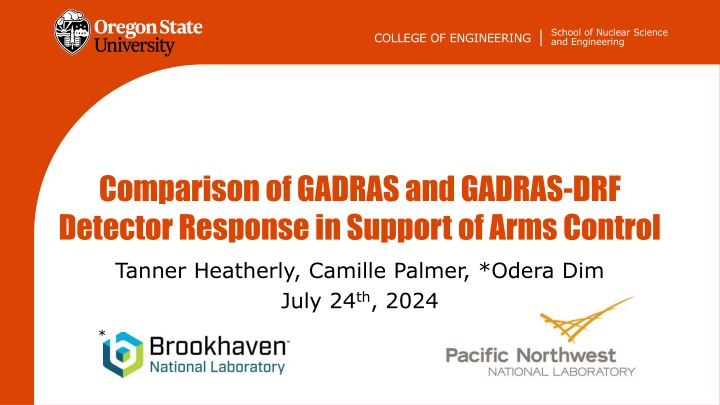
Comparison of Nuclear Detector Software: GADRAS vs GADRAS-DRF 2024 Study
Analyzing the performance of GADRAS and GADRAS-DRF detector response software for arms control applications. Explore the capabilities of these tools in generating synthetic spectra efficiently and reliably, along with insights on their use in isotope identification. Learn about the strengths and limitations of GADRAS software by Sandia National Laboratories compared to MCNP by Los Alamos National Laboratory.
Download Presentation

Please find below an Image/Link to download the presentation.
The content on the website is provided AS IS for your information and personal use only. It may not be sold, licensed, or shared on other websites without obtaining consent from the author. If you encounter any issues during the download, it is possible that the publisher has removed the file from their server.
You are allowed to download the files provided on this website for personal or commercial use, subject to the condition that they are used lawfully. All files are the property of their respective owners.
The content on the website is provided AS IS for your information and personal use only. It may not be sold, licensed, or shared on other websites without obtaining consent from the author.
E N D
Presentation Transcript
School of Nuclear Science and Engineering COLLEGE OF ENGINEERING Comparison of GADRAS and GADRAS-DRF Detector Response in Support of Arms Control Tanner Heatherly, Camille Palmer, *Odera Dim July 24th, 2024 * *
Arms Control Future arms control treaties could limit the total number of nuclear warheads Could involve onsite inspection of individual nuclear weapons. Passive ?-detectors with information barriers (IBs) useful for U235 enrichment or Pu239 characterization.
?-Spectroscopy & Machine Learning (ML) Recent efforts for different ML approaches for isotope identification from ?-spectra. Requires thousands of spectra to be generated How do you generate large amounts of synthetic ?-spectra efficiently and reliably?
GADRAS Gamma Detector Response and Analysis Software by Sandia National Laboratories Special-use code designed to reproduce detector responses efficiently and accurately for simple scenarios Radiation transport based on PARTISN Can generate large volumes of spectra in minutes
GADRAS-DRF GADRAS Detector Response Function Certain functionality disabled, including complex radiation transport Neutron / electrons and x-ray fluorescence disabled. As of 2024, 1D / 3D modeling was introduced to GADRAS-DRF.
MCNP Monte-Carlo N-Particle by Los Alamos National Laboratory Incredibly well validated and verified Complex 3D modeling capabilities Computationally expensive compared to GADRAS
MCNP vs. GADRAS MCNP and GADRAS perform well when compared to benchmark measurements* GADRAS better suited for capturing scenario with low interaction probability MCNP is a general-purpose transport code, better characterization of scattering. What about GADRAS vs. GADRAS-DRF? *K. A. STULTS, M. R. JAMES, M. LOMBARDI, and M. L. KLASKY, Comparison of Modeled to Measured Spectra using MCNP and GADRAS to Benchmark and Contrast Modeling Limitations, .
Configurations MCNP Sources created using MCNP Intrinsic Source Constructor (MISC) FWHM = ? + ? ? 4e11 particles simulated <50 keV photons behind detector were killed Photons spawned in outermost 1mm layer
Configurations GADRAS/GADRAS-DRF Sources created by GADRAS FWHM needed @ 0 and 1332 keV 1 hour real-time HPGe SNM ? 100 cm *not to scale Both 100 cm detector standoff No environmental background
Results (Uranium) % difference in CPS between GADRAS / GADRAS-DRF. Positive values represent higher GADRAS vs. GADRAS-DRF.
Results (Plutonium) % difference in CPS between GADRAS / GADRAS-DRF. Positive values represent higher GADRAS vs. GADRAS-DRF.
Results (Fresh 90% Pu239) GADRAS GADRAS-DRF MCNP
Results (Fresh 90% Pu239) GADRAS GADRAS-DRF MCNP
Results (Fresh 90% Pu239) GADRAS GADRAS-DRF MCNP
Results (Aged 98% Pu239) GADRAS GADRAS-DRF
Discussion Good agreement between GADRAS and GADRAS-DRF. Slightly higher deadtime in GADRAS-DRF spectra compared to GADRAS Likely due to full radiation transport implementation Simulation time: GADRAS / GADRAS-DRF: a few minutes MCNP: several days
Discussion MCNP results not tabulated Reduced spawning region allowed more photons to reach detector, but Self-shielding information lost, CPS unagreeable with GADRAS / GADRAS-DRF Better variance reduction or different configurations necessary to better assess MCNP results.
Conclusion GADRAS and GADRAS-DRF results agree within a few percent. GADRAS/GADRAS-DRF substantially quicker than MCNP in these scenarios. MCNP peaks properly identified, but count rates are awry due to loss of self-shielding info.
Future Work Spectra generation in progress Various shielding materials, SNM dimensions, age, etc... Training ML model using ?-spectra; how can we protect potentially sensitive ML analysis? PROACTIVE FA3: ML Information Barriers with Homomorphic Encryption (FHE)
Acknowledgements This research was supported by the U.S. National Nuclear Security Administration (NNSA) Office of Defense Nuclear Nonproliferation Research and Development within the U.S. Department of Energy under Contract No. 691756.
References 1. WARREN, G. A., ARCHER, D. E., CUNNINGHAM, MARK, MCCONCHIE, SETH, THRON, and JONATHON, Concepts for the Measurements Subsystems of the Third Generation Attributes Measurement System, (7 2012). M. C. OWEN, M. J. AITKENHEAD, and D. M. CHAMBERS, Artificial Neural Network for Arms Control and Treaty Accountable Items, Proceedings of the 2010 INMM Annual Meeting (2010). M. S. BANDSTRA, J. C. CURTIS, J. M. G. JR, A. C. JONES, and T. H. Y. JOSHI, Explaining machine-learning models for gamma-ray detection and identification, PLOS One (2023). A. KHATIWADA, M. KLASKY, M. LOMBARDI, J. MATHENY, and A. MOHAN, Machine Learning technique for isotopic determination of radioisotopes using HPGe -ray spectra, Nuclear Instruments and Methods in Physics Research Section A: Accelerators, Spectrometers, Detectors and Associated Equipment, 1054, 168409 (2023). S. M. HORNE, G. G. THORESON, L. A. THEISEN, D. J. MITCHELL, L. HARDING, and W. A. AMAI, GADRAS-DRF 18.5 User s Manual. (12 2014). K. A. STULTS, M. R. JAMES, M. LOMBARDI, and M. L. KLASKY, Comparison of Modeled to Measured Spectra using MCNP and GADRAS to Benchmark and Contrast Modeling Limitations, . C. SOLOMON JR., C. R. BATES, and M. J. MARCATH, MCNP Intrinsic Source Constructor (MISC): A User s Guide, (4 2021). 8 High-Performance Germanium Coaxial Detectors for Safeguards and Non-Destructive Assay Product Configuration Guide. D. REILLY, N. ENSSLIN, H. J. SMITH, and S. KREINER, Passive nondestructive assay of nuclear materials, . 2. 3. 4. 5. 6. 7. 8. 9.
